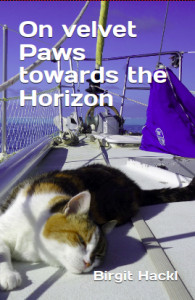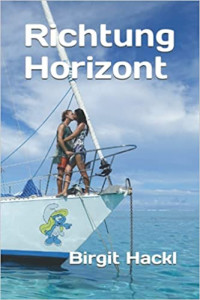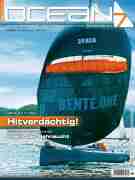The last two days were long, exciting, vibrating and exhausting. We had a fishing boat rented to take us over from Tahuata to the neighbouring island Hiva Oa and after a calm period the wind was up to 20 knots, the waves accordingly high and the 1 hour ride in the small boat quite adventurous–especially as we had a similar boat following in our wake, so we could watch them climbing up the waves, sliding down the valleys knowing that our boat was doing just the same…
When we saw the boats that were anchored outside the breakwater rolling and pitching like on passage and the tight anchor field behind the breakwater, we were glad that we had decided to leave Pitufa in the calm bay of Hanatefau (leaving Leeloo in these conditions wouldn’t have been fair and getting sleep in between the festival days impossible). The town of Atuona where most of the shows took place is half an hours walk from the dock, the organisers had tried but failed in putting up a bus system, so we had to walk to town and getting to the venues further away meant endless waiting. But that was the only negative aspect of the festival, everything else worked out perfectly.
The atmosphere in Atuona where more than a thousand participants from the different islands spent the whole week was just amazing. Friendly faces everywhere, dancers of the traditional Marquesian dance called ‘haka’ in their fabulous costumes performing or just walking around and as spectators of the other groups, artisans presenting their different handicrafts and the constant sound of drums in the air–we were overwhelmed by the impressions.
At noon all islands set up huge buffets in stands around one the venues (all for free!). The masses queued in front of the giant pots of poisson cru (marinated raw fish), meat from the umu (underground oven), breadfruit and manioc in all variations and everybody had to bring a plate, but no plastic was allowed (amazing!!), so people brought plates woven from palm trees, coconut shells, pieces of bamboo–of course we hadn’t known about that, but we got big leaves to balance our food in (quite messy with poisson cru in coconut sauce  )
)
We had missed the early morning performances, but in the afternoon a maybe not very authentic, but extremely sexy group from Easter Island danced and after that the group from Ua Pou was on. We had heard that there had been some scandal and discussion whether they’d be allowed to do their act and we soon understood why: the group carried in a huge wooden tiki (god statue), danced around it, then a dancer in a white priest robe made them take down the tiki, but soon after he was ritually killed and the tiki put back into his rightful place  Watching the savage performance it was easy to imagine why the Europeans were so scared of the Marquesan cannibals when they arrived here in the 18th century. Takitoa, a group of Marquesan expats who live in Tahiti did a rather modern version of the traditional dances, but they certainly had the most impressive tattoos of all participants (two tattoo artists from Tagaloa Tattoo where Christian and I got ours were with that group).
Watching the savage performance it was easy to imagine why the Europeans were so scared of the Marquesan cannibals when they arrived here in the 18th century. Takitoa, a group of Marquesan expats who live in Tahiti did a rather modern version of the traditional dances, but they certainly had the most impressive tattoos of all participants (two tattoo artists from Tagaloa Tattoo where Christian and I got ours were with that group).
After a break the evening program with the groups from Hiva Oa, Fatu Hiva, Tahiti, Nuku Hiva and Rikitea started with a bit of a delay in the program. As every act took over an hour with some delays in between our bottoms were put to the test sitting on rocks that seemed to get harder and more pointed by the hour. It was past midnight when the group from the Gambier finally danced in ‘rowing’ a raft over the stage.
It was past 1 o’clock in the morning when we got to our fishing boat, nobody of our cruiser’s group got to bed before half past two (the two kids who were with us kept up bravely until the end) and the fishing boat captain was back at 7 o’clock the next morning for our second day. This time the venue was far outside town on a mountain and again the transport situation was chaotic. In the end we managed to hitch there in two rides and then it was still a steep half hour climb to the historic temple site. Participants from all groups overtook us on the way up, carrying costumes and accessories–at least we could sit down once we had reached the site, for them the really strenous part was still coming.
The setting on the mountain slope, surrounded by stone walls, and the rainforest in the background was just breathtaking, the accoustics amazing and we enjoyed another 4 hours of rousing drumming, eerie woman choirs answered by hoarse warrior cries from the men–HAKA!

Festival des Arts des Iles Marquises
Every 4 years a big festival is held in one of the Marquesan islands, this year in December 2015 in Hiva Oa. We watched two days of the impressive spectacle.
(42 photos)
![]()







